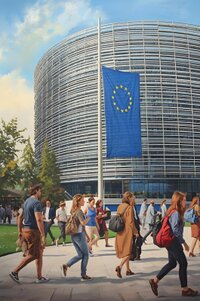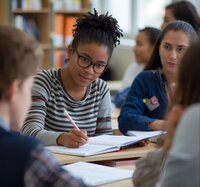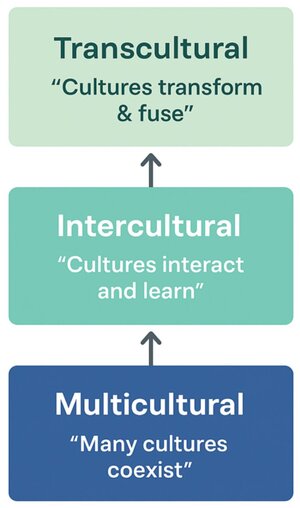Teacher Guide And Activities
Creating educational resources to support teachers at local, national, European, and global scales
in addressing the complexities of teaching multicultural classes.
The Increasing Relevance of Multicultural Education
and Inclusion in EU Educational Systems
In recent decades, Europe has undergone profound demographic, cultural, and social transformations. Migration flows, globalisation, and the rapid movement of people and information have reshaped the continent’s social fabric. These changes have turned European societies—and consequently their educational systems—into increasingly diverse and multicultural spaces. As a result, multicultural education and inclusion have become essential priorities for the European Union (EU) and its member states, not only as moral imperatives but also as strategic tools for promoting social cohesion, active citizenship, and democratic participation.
1. The European Context and Policy Framework
The European Union has long recognized education as a key driver for inclusion and intercultural understanding. Through initiatives such as the Council of Europe’s “Education for Democratic Citizenship and Human Rights Education” (EDC/HRE) and the European Education Area, the EU promotes  policies that encourage schools to become inclusive learning environments where diversity is valued as a source of enrichment rather than division. reed more
policies that encourage schools to become inclusive learning environments where diversity is valued as a source of enrichment rather than division. reed more
 policies that encourage schools to become inclusive learning environments where diversity is valued as a source of enrichment rather than division. reed more
policies that encourage schools to become inclusive learning environments where diversity is valued as a source of enrichment rather than division. reed moreThe Erasmus+ programme plays a particularly important role in fostering intercultural dialogue among young people, educators, and institutions. Its focus on inclusion, equality, and participation has contributed to shaping a European identity rooted in respect for diversity and shared values.
The EU’s Action Plan on Integration and Inclusion (2021–2027) explicitly underlines the importance of strengthening inclusive education as a foundation for the integration of migrants and minorities. It acknowledges that equitable access to quality education is not only a human right but also a cornerstone of social and economic resilience. In line with the European Pillar of Social Rights, the EU promotes inclusive education systems that ensure equal opportunities for all learners, regardless of background.
2. From Multicultural to Intercultural Education
While “multicultural education” traditionally referred to the coexistence of different cultural groups within the same learning environment, recent European educational discourse increasingly emphasizes an intercultural approach. Intercultural education focuses on dialogue, interaction, and cooperation between students of different backgrounds. It encourages critical thinking, empathy, and mutual respect.
In practice, this means adapting curricula and teaching methods to include diverse perspectives and cultural narratives. Subjects such as history, literature, and the arts can be powerful vehicles for promoting cultural understanding when they highlight multiple viewpoints. Language education is particularly significant: multilingualism is not only an asset for communication but also a symbol of Europe’s cultural richness. Recognizing and valuing students’ home languages enhances inclusion and fosters mutual curiosity.
In practice, this means adapting curricula and teaching methods to include diverse perspectives and cultural narratives. Subjects such as history, literature, and the arts can be powerful vehicles for promoting cultural understanding when they highlight multiple viewpoints. Language education is particularly significant: multilingualism is not only an asset for communication but also a symbol of Europe’s cultural richness. Recognizing and valuing students’ home languages enhances inclusion and fosters mutual curiosity.
3. Inclusion as a Fundamental Principle
Inclusion extends beyond ethnicity or cultural identity. It embraces all forms of diversity, including gender, disability, socioeconomic background, and linguistic proficiency. The EU promotes an inclusive education model that removes barriers to participation and ensures that every learner can succeed according to their potential.
Inclusive education requires systemic change, not merely pedagogical adjustments. Schools must adopt flexible, learner-centered methods and invest in teacher training that builds intercultural competence and awareness of unconscious bias. Teachers are crucial agents of inclusion; they need continuous professional development and institutional support to manage diverse classrooms effectively. Collaboration among schools, families, and communities further strengthens social inclusion and shared responsibility.
4. Challenges and Opportunities
Despite significant progress, many challenges remain. Educational segregation persists in several EU countries, particularly affecting migrant and Roma students. Structural inequalities, language barriers, and socio-economic disadvantages can limit access to quality education. Moreover, many educators report feeling underprepared to address cultural diversity or to use inclusive pedagogies effectively.
At the same time, these challenges provide opportunities for innovation. Digital and virtual learning environments allow greater intercultural collaboration and exchange, reducing geographical barriers. Platforms such as eTwinning and School Education Gateway promote teacher cooperation and the sharing of inclusive teaching materials. Furthermore, the use of arts and cultural education—including music, architecture, and the performing arts—has shown strong potential to foster empathy, emotional connection, and social inclusion, creating shared spaces of creativity that transcend cultural boundaries.
5. The Broader Impact on European Identity and Citizenship
Promoting multicultural and inclusive education directly supports the construction of a European identity that is pluralistic, open, and dynamic. By learning to engage constructively with different perspectives, students cultivate a sense of belonging to a shared European community based on human rights and democracy.
Inclusive education thus serves both individual and collective goals: it enhances learners’ well-being, employability, and intercultural competence, while strengthening the social fabric of European societies. In an era marked by polarization and misinformation, schools that embrace diversity become vital spaces for cultivating critical thinking, respect, and civic engagement.
In practice, this means adapting curricula and teaching methods to include diverse perspectives and cultural narratives. Subjects such as history, literature, and the arts can be powerful vehicles for promoting cultural understanding when they highlight multiple viewpoints. Language education is particularly significant: multilingualism is not only an asset for communication but also a symbol of Europe’s cultural richness. Recognizing and valuing students’ home languages enhances inclusion and fosters mutual curiosity.
6. Conclusion
The increasing relevance of multicultural education and inclusion in EU educational systems reflects Europe’s evolving understanding of itself and its future. Education is not merely a process of transmitting knowledge but a transformative force shaping democratic life and social cohesion. By investing in inclusive, intercultural education, the European Union reaffirms its commitment to building societies that are both diverse and united.
Real progress depends on translating these principles into everyday practice: through teacher empowerment, curriculum innovation, and sustained collaboration across borders. Only by doing so can European education truly embody the EU’s founding motto—“United in diversity.”
References (APA 7th edition)
- Council of Europe. (2018). Reference Framework of Competences for Democratic Culture. Strasbourg: Council of Europe Publishing.
- European Commission. (2020). Action Plan on Integration and Inclusion 2021–2027. Brussels: European Union.
- European Commission. (2021). European Education Area: Achieving the Vision by 2025. Luxembourg: Publications Office of the European Union.
- European Parliament. (2018). The Implementation of the European Pillar of Social Rights. Brussels: European Parliament.
- Nieto, S., & Bode, P. (2018). Affirming Diversity: The Sociopolitical Context of Multicultural Education (7th ed.). New York: Pearson.
- UNESCO. (2017). A Guide for Ensuring Inclusion and Equity in Education. Paris: UNESCO Publishing.
֍
Understanding the Difference:
Multicultural, Intercultural, and Transcultural Aspects
This paragraph explains the conceptual and practical differences among multicultural, intercultural, and transcultural aspects, which are fundamental to understanding diversity, dialogue, and transformation in education, culture, and society. The progression from multicultural to intercultural and transcultural represents a movement from coexistence, to communication, to innovation.
1. Multicultural
The term multicultural refers to the coexistence of different cultural groups within a given society, institution, or environment. Each culture retains its identity, traditions, and values, often existing side by side with limited interaction.
- Key Characteristics:
- Focuses on diversity and representation (“many cultures together”).
- Values cultural differences but may not necessarily promote deep exchange.
- Commonly associated with recognition and tolerance of diversity.
- Risk: cultural groups may remain segregated or only superficially integrated
Example:
A school that celebrates different national holidays (e.g., Diwali, Christmas, Eid)
without integrating these perspectives into daily learning practices.
2. Intercultural
Intercultural goes a step further — it emphasises interaction, dialogue, and mutual learning among cultures. It is not just about coexistence but about exchange and transformation through communication.
- Key Characteristics:
- Focuses on communication, empathy, and cooperation.
- Promotes active engagement between cultural groups.
- Encourages understanding, negotiation, and critical reflection on one’s own culture.
- Often linked to education, diplomacy, and community cohesion.
Example:An intercultural classroom where students from different backgroundscollaboratively create a project and learn from one another’s perspectives.
3. Transcultural
Transcultural refers to processes that go beyond specific cultures to create new, hybrid cultural forms. It highlights the dynamic, fluid nature of identity and culture in a globalized world.
Transcultural refers to processes that go beyond specific cultures to create new, hybrid cultural forms. It highlights the dynamic, fluid nature of identity and culture in a globalized world.
- Key Characteristics:
- Focuses on fusion, hybridity, and transformation.
- Recognizes that cultural boundaries are porous and evolving.
- Moves beyond “us vs. them” frameworks — cultures are seen as interconnected systems.
- Relevant in digital culture, global art, and intercultural innovation.
Example:A music project blending African rhythms, European classical structure,and digital soundscapes, producing a new transcultural expression.
3. Comparison Table

4. Conceptual Diagram
Interpretation:
- Multiculturalism = Coexistence
- Interculturalism = Communication
- Transculturalism = Creation
These three dimensions form a continuum, moving from awareness of diversity to dialogue and ultimately to transformation.
6. Education and EU Contexts
- Multicultural education values diversity and inclusion of multiple cultural perspectives in curricula.
- intercultural education develops competences for dialogue, empathy, and cooperative learning.
- Transcultural learning prepares students for a globalized, digital society where identities and ideas constantly intersect and evolve.
֍
Music and the Arts in Primary Education:
Building Empathy, Emotional Intelligence, and Respect for Diversity
In today’s globalized world, classrooms are more diverse than ever before. Children come from different linguistic, cultural, and social backgrounds, bringing with them a variety of experiences, traditions, and ways of seeing the world. For teachers, this diversity represents both a challenge and a profound opportunity. More than simply teaching facts and skills, educators have the responsibility to cultivate empathy, respect, and emotional understanding among their students.
Music and the arts offer one of the most effective and joyful paths to achieving this. Through singing, dancing, drawing, acting, and creating together, children learn to express themselves, listen to others, and appreciate the beauty of difference. These activities do not only nurture creativity, they are powerful tools for social growth, emotional intelligence, and intercultural understanding.
1. The Power of Music and Art in the Classroom
Music and art engage children’s minds, hearts, and bodies simultaneously. They invite participation, imagination, and collaboration. In a primary school setting, this means that every child, regardless of language ability, learning style, or background, can find a voice.
A song, a rhythm, or a shared painting project can connect children beyond words. Music in particular provides a universal language through which children can communicate feelings and ideas even when they do not yet share the same spoken language. It promotes inclusion, giving every child an opportunity to belong.
Moreover, the arts offer a safe space for self-expression. A shy or anxious pupil may find it easier to communicate emotions through drawing or singing than through speaking. When teachers incorporate the arts into daily learning, they help children develop confidence and emotional literacy—the ability to recognize and name emotions in themselves and others.
2. Developing Empathy and Emotional Intelligence through Creative Practice
Empathy is one of the most important social skills a child can learn. It is also a foundation for tolerance and peaceful coexistence. Engaging with music and the arts naturally cultivates empathy because it requires listening, feeling, and responding.
When children sing in a choir, play in a rhythm circle, or perform a short drama, they must listen to one another carefully and adjust their own contribution to the group. They learn that their success depends on cooperation and mutual respect. This experience mirrors social life outside the classroom, teaching them to value teamwork, patience, and understanding.
Art activities also help children understand emotions. For instance, discussing how a piece of music makes them feel or how colors in a painting express different moods encourages emotional reflection. Over time, this strengthens emotional intelligence—the ability to manage one’s feelings and respond sensitively to others.
Teachers can nurture this growth by integrating small reflective moments into artistic lessons:
- After a song, ask children how the music made them feel.
- When exploring a story or picture, ask them to imagine what the characters might be feeling.
- During group work, highlight moments of kindness and cooperation.
Such discussions turn artistic activities into opportunities for deep emotional learning.
3. Promoting Tolerance and Respect for Cultural Diversity
In multicultural classrooms, music and the arts provide an ideal setting for learning about and celebrating cultural diversity. Every culture has its own artistic expressions—songs, dances, stories, and visual traditions—that can become bridges between children.
Teachers can use simple activities to introduce this dimension:
- Explore songs or lullabies from different countries represented in the classroom.
- Celebrate festivals by learning traditional dances or creating art inspired by different traditions.
- Invite parents or community members to share music or crafts from their cultures.
The MILKI-WAY project experience is based on the fact that every country in the world puts its signature in its music.
Music is at the very essence of the cultural roots of any nation, and music instruments are at the heart of any tradition.
The project exposes children to the variety of cultures present in their school and community, fostering a sense of respect for diversity and promoting social inclusion and cohesion, ultimately leading to enjoyment of these shared experiences.
Such experiences allow children to see diversity as a source of richness rather than division. They discover that, even though people may dress, speak, or eat or celebrate differently, everyone shares the same emotions, joy, sadness, excitement, love and these can be expressed through art. This realization fosters mutual respect and curiosity instead of fear or prejudice.
Music and art also encourage intercultural dialogue. When children learn a song in another language, they not only acquire new words but also connect with the culture’s rhythm and emotion. This embodied understanding is far more powerful than abstract knowledge, it touches the heart as well as the mind.
4. Practical Benefits for Social and Cognitive Development
Beyond empathy and tolerance, the arts have well-documented benefits for cognitive and social development. Studies show that regular participation in music and creative activities enhances memory, attention, coordination, and problem-solving skills. Group activities like choir singing or ensemble playing also teach turn-taking, leadership, and cooperation.
For teachers, integrating the arts does not require special equipment or musical training. Simple activities—clapping rhythms, inventing classroom songs, storytelling with sound effects, or drawing to music—can make learning more engaging and meaningful. Artistic expression should not be an isolated subject but woven through the curriculum, supporting literacy, numeracy, and science through creative exploration.
5. The Teacher’s Role: Modelling Openness and Creativity
Teachers play a crucial role in shaping the classroom’s emotional and cultural climate. When educators show curiosity, openness, and respect for different artistic traditions, children naturally follow their example.
Creating an inclusive and creative classroom means valuing each child’s contribution and background. Teachers can invite students to share songs or art from their families, encouraging pride in their heritage while fostering mutual respect among peers.
Importantly, teachers should emphasize that there are no mistakes in art—only exploration. This approach nurtures resilience, self-acceptance, and confidence. By showing that creativity flourishes in diversity, teachers prepare students for a world where flexibility, empathy, and collaboration are essential skills.
To write new activities,
you can download the template here.









